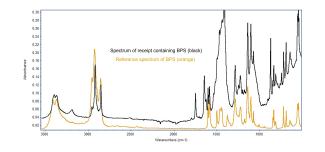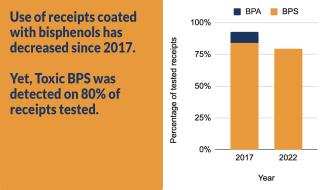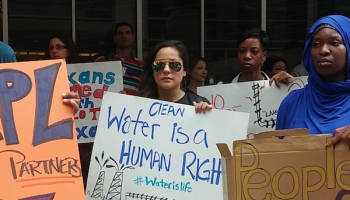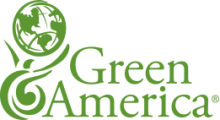Update
Our peer-reviewed scientific paper expanding on this study was published in Environmental Pollution in 2023. We also carried out a follow-up study in collaboration with Cox Media Group, resulting in TV stories across the U.S. about bisphenols in receipts.
Introduction
Purchase receipts are an underrecognized source of hormone-disrupting chemicals in our bodies–especially for workers who frequently handle receipts. In 2022, we followed up on an earlier study we published in 2018, More Than You Bargained For, to assess retailers’ progress in eliminating receipts containing bisphenols. Bisphenols, particularly bisphenol A (BPA) and bisphenol S (BPS), are chemicals linked to reproductive harm that are present in high concentrations when used in receipt paper.
We tested 374 receipts from 144 major chain stores in 22 U.S. states and the District of Columbia. The most common were grocery stores, restaurants, and big box stores. We found bisphenol (BPS or BPA) receipt usage among these companies decreased from 93% in 2017 to 80% in 2022 and the use of non-bisphenol alternatives increased from 2% to 20%. We also found that BPA-based receipts have been almost entirely replaced by BPS.
We emphasize that the best solution is for businesses to reduce printing receipts in the first place by offering no receipt and digital receipt options.
States are beginning to take action. As of early 2023, the state of Washington’s Department of Ecology has proposed to prohibit the use of bisphenols as a class in receipts and would be the first state in the country to do so. Also, California’s Assembly Member Phil Ting has proposed legislation to prohibit bisphenols in receipts and to require stores to allow customers to choose a no-receipt option.
Nearly all receipts are made from thermal paper, which is coated with layers of chemicals that allow an image to form when a special print head applies heat. The “developer” layer is the target of this study. We used a rapid screening technique to identify the developer chemicals, including BPS, BPA, and non-bisphenol alternatives present on the receipts.
Sample Collection
Volunteers collected cash register receipts from January to November of 2022. Contributors were instructed to fold receipts with the printed side in to avoid transferring chemicals from one receipt to another. We received receipts from 22 U.S. states and Washington, D.C., with the majority from southeast Michigan. While not exhaustive, the data represent a wide range of major retail stores visited by people in their daily lives.
Several popular retailers had multiple receipts included in the testing because we collected from different store locations. We also tested some receipts from one location but printed on different dates.
This report includes receipts from national businesses (those with stores in more than 10 states) and large regional businesses (those with stores in 6-10 states). Additional data, including test results from smaller, local businesses’ receipts, will be included in an upcoming scientific journal article.
How We Tested Receipts
Fourier Transform Infrared (FTIR) spectroscopy is a widely used tool for determining the chemical identity of materials. A Thermo Scientific Nicolet iS5 spectrometer was used to obtain infrared spectra of each receipt. The spectra were compared against a library of reference spectra to detect the presence of BPS, BPA, or non-bisphenol developers. An example of a BPS receipt spectrum is shown in Figure 1.
This method has been previously validated [1].
We marked as “inconclusive” those spectra that suggested some kind of coating on the paper but did not match the unique FTIR fingerprint of known developers. Receipts with an “inconclusive” result probably contain an alternative developer we cannot currently identify.
We estimate this method detects developer chemicals present at roughly 5,000 parts per million or greater in receipt paper.

Results
We tested 374 receipts from 144 major chain stores in 22 U.S. states and the District of Columbia.
The category with the largest number of receipts collected was grocery stores (87), such as Kroger and Whole Foods; followed by restaurants (65), such as McDonald’s and Popeye’s; and big box or department stores (59), such as Costco and Target. Other categories included home improvement, such as Lowe’s and Ace Hardware; gas and convenience stores such as Shell and Pilot; clothing stores such as Old Navy and Athleta; discount stores such as Dollar Tree and Five Below; drugstores such as Walgreens and CVS, and many more.
Test results for the retailers' receipts can be found here.
Figure 2 shows bisphenol receipt usage by major businesses decreased from 93% in 2017 to 80% in 2022. It shows a shift away from BPA--9% of receipts had BPA in 2017 but just 0.3% in 2022--and a slight decrease in BPS from 84% to 79%. BPS appears to be a major replacement chemical for BPA in U.S. receipts.
Still, a shift away from bisphenols is occurring. Non-bisphenol alternatives accounted for 2% of major store receipts in 2017 and 20% in 2022. Pergafast 201 was the most commonly detected alternative. Further details will be reported in an upcoming scientific journal article.

Companies With Bisphenol-Free Receipts
Our test results confirmed that several companies, as pledged, have stopped using bisphenol-based receipts in their stores. These companies vary, however, in whether they offer no-receipt and digital receipt options. More information on those options is found in Green America’s Skip the Slip report. Receipts from the following retailers were bisphenol-free:
- Costco
- Culver's
- CVS*
- H&M
- Lululemon**
- REI
- Starbucks**
- Target
- Trader Joe’s
- TJX (TJ Maxx, Marshalls, Sierra Trading Post, Home Goods)
- Whole Foods*
* 7 of 8 CVS receipts tested for this study and 13 of 16 Whole Foods receipts were bisphenol-free but the others had BPS. This could be due to old supplies of BPS thermal paper being used at some stores.
**We are not aware of public commitments from Starbucks and Lululemon, but their receipts tested for this study were bisphenol-free.
We also note that Culver’s restaurant appears to use regular, uncoated paper for receipts rather than thermal paper. Uncoated receipt papers are safe to recycle.
In addition, Walgreens responded to this report by publicly pledging, in March 2023, to phase out bisphenols and offer a no-receipt option [12].
Chemicals Used in Receipt Paper
Most developer chemicals are present in high concentrations, above 1% by weight, in thermal paper. These chemicals are not strongly bound to the paper and come off easily onto the skin. Moisturizer and hand sanitizer have been found to enhance absorption through the skin [2]. Some, especially the bisphenols, can interfere with normal hormone (endocrine) function, potentially leading to developmental abnormalities or contributing to disease and obesity [3], [4].
Bisphenol A, the oldest developer chemical, is classified by the U.S. EPA as toxic to the reproductive system [5]. BPA is rapidly absorbed through the skin and into the bloodstream [6]. It is prohibited in the European Union in thermal paper above 0.02%, which effectively prevents its use there.
Bisphenol S, the most common developer used in current U.S. receipts according to our testing, was classified by U.S. EPA as a potentially high hazard for toxicity in human development. BPS absorbs through the skin, although not as rapidly as BPA [6]. The E.U. chemicals agency (ECHA) classified BPS as a reproductive toxicant, a substance of very high concern [7], and intends to regulate it [8].
Non-bisphenol developers include Pergafast 201 and Appvion Alpha Free. All non-bisphenol developers we detected in receipts will be detailed in an upcoming scientific publication.
Pergafast 201 has been subject to a GreenScreen for Safer Chemicals® hazard assessment resulting in a Benchmark 2 rating, signifying “use but search for safer substitutes” [9]. It had a “moderate” hazard score for carcinogenicity, reproductive toxicity, and developmental toxicity. Available data showed no hormonal activity, although some types of hormonal tests have not been carried out. ECHA says Pergafast 201 is “toxic to aquatic life with long lasting effects” [10]. Pergafast does not appear to appreciably absorb through the skin [6].
Appvion Alpha Free is called the “vitamin C” thermal paper because it reportedly uses vitamin C (ascorbic acid) as the developer. However, researchers have found Alpha Free paper to contain Dapsone and tolbutamide, both pharmaceuticals, instead of vitamin C [11]. The state of Washington Department of Ecology reviewed GreenScreen assessments of two Appvion tradename thermal papers and reported that both met minimum criteria (Benchmark 2) for safer substitutes [9]. However, the tradenames are not given, so we do not know whether Alpha Free was one of them.
Recommendations:
For workers:
- If possible, ask your employer to provide disposable, non-vinyl gloves. Another option is reusable, food grade silicone fingertips.
- Fold each receipt in on itself before handing to a customer. The backside is typically not coated.
- Wash and dry hands before eating and after changing receipt rolls.
- Avoid handling receipts just after using hand sanitizer or when hands are wet (these conditions increase skin absorption of developer chemicals).
- Keep drink and meal receipts dry. Do not adhere them to the sides of moist containers or place directly on food [13].
For shoppers:
- Call on your favorite retailers to “mind the store,” ban bisphenols in receipts, and ensure substitutes are safe.
- Contact your elected officials. Write to your state and federal representatives and let them know you would like them to ban bisphenols in receipts and other products in your home.
- Decline a printed receipt when possible.
- If you take a receipt, fold it printed side in. The backside is typically not coated.
- Do not hand receipts to babies or children.
- Wash hands after handling receipts [13].
- Put receipts into trash instead of recycling to avoid contaminating the recycled paper stream.
For retailers:
Two actions substantially reduce exposure of workers and customers to hormone-disrupting receipt chemicals:
- Offer customers the option of skipping a paper receipt. Offer digital receipts. See Green America’s Skip the Slip report for more on these solutions.
- Switch to non-bisphenol, less hazardous, replacement paper.
More broadly, retailers should take steps in the following areas:
- Policy: Adopt ambitious public safer chemicals policies that get ahead of the curve and ban toxic chemicals like bisphenols in receipts and other products.
- Goals and metrics: Set clear, ambitious public goals with timelines and quantifiable metrics to reduce and eliminate bisphenols in receipts.
- Transparency: Require suppliers to provide full disclosure of product ingredients.
- Avoid regrettable substitution: Assess any substitute chemicals for known hazards, or require that suppliers do so, using a method such as GreenScreen for Safer Chemicals® or ChemFORWARD to ensure that any replacement chemicals are the safest possible, meeting criteria for GreenScreen Benchmark 2 or higher or ChemFORWARD C or higher.
- Disclose progress: Provide progress reports to the public on at least an annual basis.
- Support policies in states to eliminate harmful chemicals, fill data gaps, and assess safer alternatives. Government investments and regulation of the most hazardous chemicals help to clean up the supply chain and make it more transparent for companies.
For institutions:
Governmental, educational, and health care institutions should prohibit bisphenol-based thermal paper in their purchasing policies and prioritize offering digital receipts. Thermal paper is frequently used within institutions such as in cafeterias, bookstores, and for some medical equipment readouts.
For manufacturers & suppliers:
To avoid regrettable substitution, suppliers of non-bisphenol thermal paper should perform or request from the manufacturers a comprehensive chemical hazard evaluation such as GreenScreen for Safer Chemicals® or ChemFORWARD.
Acknowledgements
We thank our partners, Green America and Toxic Free Future, for helpful discussions, communicating with retailers, and reviewing this report. We thank our student research assistants, Aminata Ndiaye and Daniela Tapia, for managing the samples and carrying out testing. We thank Ted Cullinan of TechEx Team for helpful discussions about the thermal paper market. We also thank Alister Innes and colleagues at Minnesota Pollution Control Agency for sharing Minnesota receipts, and all of the volunteers who collected and sent in purchase receipts.
Project Partners
References
[1] G. Miller and J. Gearhart, “A Rapid Screening Method for Detecting Hazardous Chemicals in Consumer Products, Food Contact Materials, and Thermal Paper Receipts Using ATR-FTIR Spectroscopy,” J. Environ. Health, vol. 85, no. 4, pp. 8–15, Nov. 2022.
[2] A. M. Hormann et al., “Holding Thermal Receipt Paper and Eating Food after Using Hand Sanitizer Results in High Serum Bioactive and Urine Total Levels of Bisphenol A (BPA),” PLoS ONE, vol. 9, no. 10, p. e110509, Oct. 2014, doi: 10.1371/journal.pone.0110509.
[3] J. R. Rochester and A. L. Bolden, “Bisphenol S and F: A Systematic Review and Comparison of the Hormonal Activity of Bisphenol A Substitutes,” Environ. Health Perspect., Mar. 2015, doi: 10.1289/ehp.1408989.
[4] H. F. Alharbi et al., “Exposure to Bisphenol A Substitutes, Bisphenol S and Bisphenol F, and Its Association with Developing Obesity and Diabetes Mellitus: A Narrative Review,” Int. J. Environ. Res. Public. Health, vol. 19, no. 23, p. 15918, Nov. 2022, doi: 10.3390/ijerph192315918.
[5] US EPA, Bisphenol A Alternatives in Thermal Paper. U.S. Environmental Protection Agency, 2015.
[6] E. Reale, D. Vernez, and N. B. Hopf, “Skin Absorption of Bisphenol A and Its Alternatives in Thermal Paper,” Ann. Work Expo. Health, vol. 65, no. 2, pp. 206–218, Mar. 2021, doi: 10.1093/annweh/wxaa095.
[7] ECHA, “Assessment of regulatory needs (bisphenols),” ECHA (European Chemicals Agency), Dec. 2021. echa.europa.eu/documents/10162/3448017/GMT_109_Bisphenols_Report_public_23502_en.pdf/ (accessed Feb. 11, 2023).
[8] Erickson, Britt, “EU regulators eye 34 bisphenols for restriction,” Chemical & Engineering News. cen.acs.org/safety/consumer-safety/EU-regulators-eye-34-bisphenols/100/i13 (accessed Feb. 12, 2023).
[9] Washington State Department of Ecology, “Regulatory Determinations Report to the Legislature, Safer Products for Washington Cycle 1 Implementation Phase 3.,” Jun. 2022. apps.ecology.wa.gov/publications/documents/2204018.pdf (accessed Feb. 10, 2023)
[10] “Substance Information - ECHA.” echa.europa.eu/substance-information/-/substanceinfo/100.103.077 (accessed Feb. 12, 2023).
[11] M. Eckardt and T. J. Simat, “Bisphenol A and alternatives in thermal paper receipts - a German market analysis from 2015 to 2017,” Chemosphere, vol. 186, pp. 1016–1025, Nov. 2017, doi: 10.1016/j.chemosphere.2017.08.037.
[12] Changeover to phenol-free receipt paper, March 17, 2023. news.walgreens.com/press-center/changeover-to-phenol-free-receipt-paper.htm (accessed Mar. 20, 2023).
[13] Minnesota Pollution Control Agency, "BPA and BPS in thermal paper." pca.state.mn.us/business-with-us/bpa-and-bps-in-thermal-paper (accessed Feb. 28, 2023).




